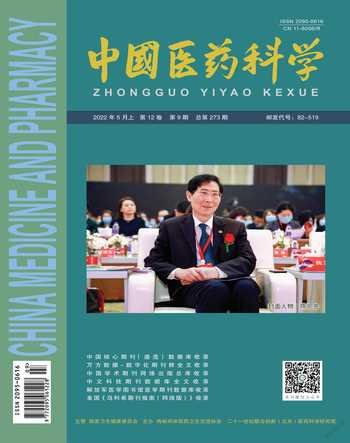肿瘤细胞衰老及相关治疗的研究进展
2022-07-13张瑞新宁方玲
张瑞新 宁方玲
[摘要]细胞衰老是一种多效性的细胞状态,贯穿于机体生理及病理多重环节的始末,维持细胞与组织自身功能及结构的动态平衡。传统意义上,细胞衰老以永久性的增殖停滞为特征,以各种治疗手段加速肿瘤细胞衰老成为既往肿瘤治疗的一大理论基石,然而,近年来人们对于细胞衰老机制的探索不断深入,发现由于肿瘤微环境中的细胞衰老现象具有特殊的生物学特性,一些衰老肿瘤细胞甚至可以“重启”细胞周期,从而实现“重生”并获得更高的侵袭能力及治疗抵抗性。研究证实,这种现象与肿瘤治疗后复发有密切关联。本文将对肿瘤细胞衰老的相关机制进行归纳总结,并对其相关诱导及清除治疗的研究进展进行综述。
[关键词]肿瘤;细胞衰老;衰老诱导治疗;细胞周期
[中图分类号] R730.5 [文献标识码] A [文章编号]2095-0616(2022)09-0062-04
Study advances in tumor cell senescence and related therapies ZHANG Ruixin NING Fangling2
1.Binzhou Medical University, Shandong, Binzhou 256603, China;2.Department of Oncology, Binzhou Medical University Hospital, Shandong, Binzhou 256603, China
[Abstract] Cell senescence is a pleiotropic cellular state that runs through the beginning and end of multiple processes of body physiology and pathology, maintaining the dynamic balance of the functions and structures of cells and tissues. Traditionally, cell senescence is characterized by permanent proliferation stagnation, and accelerating tumor cell senescence by various therapeutic means has been a major theoretical cornerstone of tumor therapy in the past. However, in recent years, the exploration on cell senescence mechanisms has been deepened, and it has been found that some senescent tumor cells can even "restart" the cell cycle due to the special biological characteristics of cell senescence in the tumor microenvironment, thus achieving "rebirth" and higher invasion ability and therapeutic resistance. And this phenomenon has been proven to be closely related to tumor recurrence after treatment. This paper summarizes the mechanisms of tumor cell senescence and reviews the study advances in the senescence-inducing and eradication therapy.
[Key words] Tumor; Cell senescence; Senescence-inducing therapy; Cell cycle
“細胞衰老”(cellular senescence)一词由 Hayflick 团队首次提出,他们观察到正常的二倍体细胞在有限次数的分裂后停止增殖,现象类似于机体衰老,故将其命名为“细胞衰老”[1]。事实上,尽管细胞衰老与机体衰老存在相关性,但二者并非对等关系。从胚胎发育到成年期的任何生命阶段,细胞在机体生长发育的任何阶段都可以经历衰老,并不受年龄限制。在胚胎发育阶段,细胞衰老有助于机体生长发育,而成年阶段,细胞衰老可以阻止受损细胞的繁殖,有助于组织修复,并起到抑制肿瘤发生的作用[2]。总之,细胞衰老是在漫长的进化过程中,细胞自身演变出一套相对完善的动态平衡调控程序。
1细胞衰老与肿瘤
1.1细胞衰老
传统理论认为细胞衰老以永久性的增殖停滞为特征,并将其视作一种细胞在面对多重内源性及外源性刺激下,维持自身状态与活性动态平衡的自我调控程序,该程序启动时往往伴有高分泌、大分子损伤和新陈代谢改变等过程,是一种具有多效性的进化演变,对机体细胞稳态的维持具有重要意义[3]。
多种信号(如端粒功能障碍、癌基因激活及持续性 DNA 损伤等)均可以刺激细胞衰老的发生[4]。相对轻微的内源性或外源性细胞损伤,通常是可逆的,损伤行为停止后细胞结构和功能的完整性也随之恢复。而细胞在经历强烈的、不可逆转的损伤时,往往激活“自杀”程序,以限制细胞损伤对组织退化的影响。细胞衰老往往是介于在这两个极端程序之间的第三种状态,从某种意义上讲,细胞衰老是一种针对有害刺激或机体异常增殖作出的警报反应[5]。
1.2肿瘤细胞衰老
在肿瘤细胞中,细胞衰老的警报反应可被强制“中断”,衰老细胞重新进入细胞周期,且获得特殊的生物活性。Saleh 团队采用流式细胞术,以衰老相关β-半乳糖苷酶(senescence-associated β-galactosidase, SA-β-gal)活性和细胞大小为特异性标志,同时利用活细胞成像和干涉计量学对化疗诱导衰老的肿瘤细胞进行筛选,证实了衰老肿瘤细胞可进行自发细胞分裂[5]。这种“重生”行为不仅在肿瘤自然发展过程中发生,经衰老诱导治疗(therapy-induced senescence, TIS)后的肿瘤细胞也可出现这种情况并且机制更为复杂。华盛顿大学研究组研究证明,p16INK4a 及 p53缺失的 H1299肺癌細胞系可以“逃逸”喜树碱诱导后的细胞衰老并恢复增殖能力,而这种恢复能力与肿瘤细胞表达细胞分裂周期蛋白的能力之间存在正相关性。
当然肿瘤细胞从衰老中“重生”比例相对较少。有研究表明,这些“重生”肿瘤细胞往往具有多倍体[6]和细胞干性及高侵袭性[7]的特征。有研究在小鼠实验中证实,这些具有干性的肿瘤细胞在体外可迅速形成细胞集落,当移植到小鼠体内时,成瘤负荷相较于对照普通肿瘤细胞系明显提高[7]。值得注意的是,这种细胞干性在 TIS 后的肿瘤细胞中更明显,这一点,在Sabisz的研究中已得以验证,在小鼠模型中接受 TIS 的肿瘤细胞有部分细胞表达干性,并介导化疗治疗耐药[8]。这个过程与衰老肿瘤细胞过度表达 CDK、Cdc2/Cdk1来逃避 TIS 以重新进入细胞周期相关[9-10]。
基于 TIS 在肿瘤治疗中的重要地位及 TIS 治疗后复发的高风险性,近年来, TIS 对于肿瘤治疗的作用是研究的热点。
2衰老细胞诱导及消除治疗
2.1衰老诱导治疗
TIS 并非某一种治疗手段,而是多种肿瘤治疗方法的统称。临床上多种手段可诱导肿瘤细胞衰老,并进一步抑制肿瘤增殖,甚至“消除”肿瘤细胞。临床上常见的化疗药物,如拓扑异构酶抑制剂、烷化剂、铂类、抗代谢剂、微管抑制剂、激素类药物;一些靶向药物、免疫检查点抑制剂及 PARP 抑制剂及蛋白酶体抑制剂,都是常见的细胞衰老诱导剂[11]。这些药物作用机制及适用瘤种各异,但均能引起肿瘤细胞上调细胞衰老经典标志物 SA-β-gal 的表达。此外,放疗射线也可以引起细胞衰老[12]。
随着肿瘤治疗手段日趋成熟,经过系统、规范的 TIS 治疗,大部分肿瘤细胞可被杀灭,患者可获得更长的生存期。事实上,并非所有患者都能从 TIS 中获益,一部分治疗后复发的患者表现出比初发时更高的转移率及病死率[11]。
2.2衰老细胞清除治疗及进展
2.2.1衰老细胞清除治疗肿瘤细胞经化疗药物或放射治疗后会进入衰老状态,一部分肿瘤细胞经治疗消除后幸存下来,并进入休眠状态。一方面,衰老肿瘤细胞通过进入长时间的生长停滞状态来逃避治疗的直接细胞毒性作用,休眠过程中可进行自我更新能力的恢复;另一方面,衰老细胞还通过 SASP 的旁分泌信号直接促进邻近细胞恶性表型转化[13]。从而导致患者在治愈原发疾病几个月甚至几年后出现恶性程度更高、进展更快的肿瘤复发。尽管复发机制复杂多样,但肿瘤细胞在接受 TIS 后的“重生”已被证明是重要一环[14-16]。
基于 TIS 的重要性及风险性,衰老细胞清除治疗在延缓及预防肿瘤复发研究中成为热点[17]。 2.2.2特异性细胞衰老抑制剂细胞分裂周期激酶(CDC7)抑制剂属于 TP53突变肝癌细胞衰老特异性抑制剂,对 TP53野生型肝癌细胞和正常细胞无衰老诱导作用。这种独特的肝癌治疗模式,被命名为“组合拳式(one-two punch)”[18]。
2.2.3凋亡蛋白选择性抑制剂 Navitoclax 是抗凋亡蛋白 bcl-2、bcl-xl 和bcl-w 的选择性抑制剂。研究证实,使用 Navitoclax 可选择性地杀死由辐射、癌基因过度表达和复制耗竭引起的各种人和鼠衰老细胞,同时还消除可红外线诱导的造血干细胞和骨髓基质细胞中的 SASP 反应,从而改善小鼠的骨髓状况,促进辐射后小鼠骨髓功能的恢复[19-20]。
2.2.4联合治疗模式研究表明达沙替尼和槲皮素具有分解衰老的潜力。达沙替尼是一种小分子酪氨酸激酶抑制剂,单独使用可以消除衰老的人类脂肪细胞;而槲皮素是一种黄酮醇,大量存在于天然饮食中,单独使用可以更有效地对抗衰老的人类内皮细胞。小鼠模型中证实,“D+Q 模式”联合用药对消除衰老的小鼠胚胎成纤维细胞比单独使用每种药物更有效[21]。
此外,姜黄素[22]、Fisetin[23]、二甲双胍[24]、 Panobinostat[25]、溶酶体抑制剂(如巴菲霉素 A1等)[26]、非诺贝特[27]、强心苷[28]等药物均可作为 TIS 治疗后残留的衰老肿瘤细胞的“清除剂”,以达到延缓或预防肿瘤复发的目的。
3展望
细胞衰老贯穿于机体生长发育的始末,宏观上由动态遗传和表观遗传过程共同决定,是一种相对稳定的增殖停滞状态。在生理状态下,通过调控机体生长、发育及组织修复、更新,起到正向保护作用。基于此,TIS 应运而生,传统放化疗日趋成熟,靶向及免疫治疗也为晚期肿瘤患者带来了生存获益。然而,随着我国医疗卫生事业的蓬勃发展,医学技术的日益精进,肿瘤患者在生存期延长的同时,复发问题也日渐暴露。其中,大量研究数据证实 TIS 相关衰老细胞积累与复发相关。近年来,衰老细胞的清除治疗成为热点话题。然而,这些治疗模式尚未在临床上广泛应用,细胞衰老相关检测生物学标志物也多局限于实验室内,希望在不久的将来,这些治疗手段能为临床肿瘤患者带来预后及生存期的切实获益。
[参考文献]
[1] Hayflick L,Moorhead PS.The serial cultivation of humandiploid cell strains[J].Experimental Cell Research,1961,25(3):585-621.
[2] Vassilis Gorgoulis,Peter D. Adams,Andrea Alimonti,et al.Cellular Senescence: Defining a Path Forward[J].Cell,2019,179(4):813-827.
[3] Gorgoulis Vassilis G,Pefani Dafni-Eleftheria, PaterasIoannis S,et al.Integrating the DNA damage and protein stress responses during cancer development and treatment[J]. The Journal of Pathology,2018,246(1):12-40.
[4] Rodier Francis,CampisiJudith.Four faces of cellularsenescence[J].The Journal of Cell Biology,2011,192(4):547-556.
[5] Saleh T,Tyutyunyk-Massey L,Gewirtz DA.Tumor CellEscape from Therapy-Induced Senescence as a Model of Disease Recurrence after Dormancy[J].Cancer Res,2019,79(6):1044-1046.
[6] Rajaraman Rengaswami,Guernsey Duane,RajaramanMurali,et al.Stem cells, senescence, neosis and self- renewal in cancer[J].Cancer Cell International,2006,6(1):25-26.
[7] Milanovic Maja,Fan Dorothy NY,Belenki Dimitri,et al.Senescence-associated reprogramming promotes cancer stemness[J].Nature,2018,553(7686):96-100.
[8] Was Halina,Barszcz Kamila,Czarnecka Joanna,et al.Bafilomycin A1 triggers proliferative potential of senescent cancer cells in vitro and in NOD/SCID mice[J]. Oncotarget,2017,8(6):9303-9322.
[9] Elmore Lynne W,Di Xu,Dumur Catherine,et al.Evasion of a single-step, chemotherapy-inducedsenescence in breast cancer cells: implications for treatment response[J].Clinical Cancer Research,2005,11(7):2637-2643.
[10] Roberson Rachel S,Kussick Steven J,VallieresEric,et al.Escape from therapy-induced accelerated cellular senescence in p53-null lung cancer cells and in human lung cancers[J].Cancer research,2005,65(7):2795-2803.
[11] Gilioli Diego, Fusco Simona, Giannetti Kety, et al.Therapy-Induced Senescence As an Anti-Cancer and Immune-Stimulatory Strategy[J].Blood,2021,138(9):4419.
[12] A.F.S.Tabasso,D.J.L.Jones,G.D.D.Jones,et al.Radiotherapy-Induced Senescence and its Effects on Responses to Treatment[J].Clinical Oncology,2019,31(5):283-289.
[13] Campisi J,Andersen JK,Kapahi P,et al .Cellular senescence: A link between cancer and age- related degenerative disease?[J].Seminars in Cancer Biology,2011,21(6):354-359.
[14] Zhao Qianqian,Chen Gang,Ye Luxi,et al.Clinicaloutcomes of stereotactic body radiotherapy for de novo pulmonary tumors in patients with completely resected early stage non-small cell lung cancer[J]. Cancer Management and Research,2018,10(5):6391-6398.
[15] Daniel E.Spratt,Abraham J.Wu,Victoria Adeseye,et al.Recurrence Patterns and Second Primary Lung Cancers After Stereotactic Body Radiation Therapy for Early- Stage Non –Small-Cell Lung Cancer: Implications forSurveillance[J].Clinical Lung Cancer,2016,17(3):177-183.
[16] Khor RC,Bressel M, Tedesco J,et al.Tolerabilityand outcomes of curative radiotherapy in patients aged85 or more years[J].Med J Aust,2015,202(3):153-155.
[17] Kirkland JL,Tchkonia T .Clinical strategies andanimal models for developing senolytic agents[J].Exp Gerontol,2015,25(7):19-25.
[18] Wang Cun,Vegna Serena,JinHaojie,et al.Inducingand exploiting vulnerabilities for the treatment of liver cancer[J].Nature,2019,574(7):268-272.
[19] Chang Jianhui,Wang Yingying,Shao Lijian,et al.Clearance of senescent cells by ABT263 rejuvenates aged hematopoietic stem cells in mice[J].NatureMedicine,2016,22(1):78-83.
[20] Zhu Yi,Tchkonia Tamara,Fuhrmann-StroissniggHeike,et al.Identification of a novel senolytic agent, navitoclax, targeting the Bcl-2 family of anti-apoptotic factors[J].Aging Cell,2016,15(3):428-435.
[21] Zhu Y,Tchkonia T,Pirtskhalava T,et al .TheAchilles'heel of senescent cells: from transcriptome to senolytic drugs[J].Aging Cell,2015,14(4):771-782.
[22] Li Wen,He Yonghan,Zhang Rongping,et al.Thecurcumin analog EF24 is a novel senolytic agent[J]. Aging,2019,11(2):644-658.
[23] Uxía Nogueira-Recalde,Irene Lorenzo-Gómez,Francisco J. Blanco,et al.Fibrates as drugs with senolytic and autophagic activity for osteoarthritis therapy[J].E Bio Medicine,2019,45(7):588-605.
[24] Zhu Y,Doornebal EJ,Pirtskhalava T,et al.Newagents that target senescent cells: the flavone, fisetin, and the BCL-XL inhibitors, A1331852 and A1155463[J]. Aging (Albany NY),2017,9(3):955-963.
[25] Kumar Ravi,Sharma Anamika,Kumari Amita,et al.Epigallocatechin gallate suppresses premature senescence of preadipocytes by inhibition of PI3K/Akt/ mTOR pathway and induces senescent cell death by regulation of Bax/Bcl-2 pathway[J].Biogerontology,2019,20(2):171-189.
[26] Hartman Mariusz L,Sztiller-Sikorska Malgorzata,CzyzMalgorzata.Whole-exome sequencing reveals novel genetic variants associated with diverse phenotypes of melanoma cells[J].Molecular Carcinogenesis,2018,58(4):171-189.
[27] Marta Anna Szychlinska, Silvia Ravalli, GiuseppeMusumeci.Pleiotropic effect of fibrates on senescence and autophagy in osteoarthritis[J].E Bio Medicine,2019,45(8):122-125.
[28] Triana-Martínez Francisco,Picallos-Rabina Pilar,DaSilva-Álvarez Sabela, et al.Identification and characterization of Cardiac Glycosides as senolytic compounds[J].Nature Communications,2019,10(1):4731.
(收稿日期:2022-01-19)
